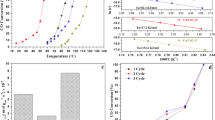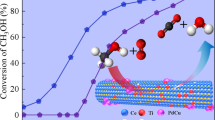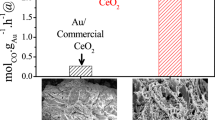Abstract
With the rapid development of transportation and vehicles, the elimination of NOx and CO has highly attracted public attention. In this work, vacancy-rich CeO2 nanopencil supported CuO catalysts (CuO/CeO2-NPC) were successfully prepared for NO reduction by CO. Importantly, CeO2 with nanopencil-like shape (CeO2-NPC) have been synthesis by solvothermal method for the first time. The physicochemical properties of all samples were studied in detail by combining the means of X-ray diffraction (XRD), Raman spectroscopy, electron paramagnetic resonance (EPR), X-ray photoelectron spectroscopy (XPS), H2-temperature-programmed reduction (H2-TPR), transmission electron microscopy (TEM), scanning electron microscopy (SEM), N2 physisorption (Brunauer–Emmett–Teller), and NO and CO temperature-programmed desorption (NO-TPD and CO-TPD) techniques. Compared with CeO2 nanorods and nanoparticles supported CuO catalysts (CuO/CeO2-NR and CuO/CeO2-NP), the CuO/CeO2-NPC catalysts showed the highest catalytic activity, affording more than 90% NO conversion at 69 °C as well as excellent H2O tolerance at 150 °C, which is superior to catalysts previously reported. Characterization results indicated that the synergistic effect between the well-dispersed CuO and the CeO2 nanopencil support enables a favorable electron transfer between these components and enhances the density of surface oxygen vacancies and Cu+ species, which consequently accelerating the redox cycle. The results indicated that the morphology control of CeO2 support could be an efficient way to evidently enhance the catalytic performance for NO + CO reaction.






Similar content being viewed by others
Data availability
The datasets used and analyzed during the current study are available from the corresponding author on reasonable request.
References
Bai Y, Bian X, Wu W (2019) Catalytic properties of CuO/CeO2-Al2O3 catalysts for low concentration NO reduction with CO. Appl Surf Sci 463:435–444. https://doi.org/10.1016/j.apsusc.2018.08.229
Chen JF, Zhu JJ, Zhan YY, Lin XY, Cai GH, Wei KM, Zheng Q (2009) Characterization and catalytic performance of Cu/CeO2 and Cu/MgO-CeO2 catalysts for NO reduction by CO. Appl Catal a: Gen 363:208–215. https://doi.org/10.1016/j.apcata.2009.05.017
Chen Y, Li Y, Chen W, Xu WW, Han ZK, Waheed A, Ye Z, Li G, Baiker A (2022) Continuous dimethyl carbonate synthesis from CO2 and methanol over BixCe1-xOδ monoliths: effect of bismuth doping on population of oxygen vacancies, activity, and reaction pathway. Nano Res 15:1366–1374. https://doi.org/10.1007/s12274-021-3669-4
Cheng XX, Zhang XY, Su DX, Wang ZQ, Chang JC, Ma CY (2018) NO reduction by CO over copper catalyst supported on mixed CeO2 and Fe2O3: catalyst design and activity test. Appl Catal B 239:485–501. https://doi.org/10.1016/j.apcatb.2018.08.054
Damma D, Ettireddy PR, Reddy BM, Smirniotis PG (2019) A review of low temperature NH3-SCR for removal of NOx. Catal 9:349. https://doi.org/10.3390/catal9040349
Davó-Quiñonero A, Bailón-García E, López-Rodríguez S, Juan-Juan J, Lozano-Castelló D, García-Melchor M, Herrera FC, Pellegrin E, Escudero C, Bueno-López A (2020) Insights into the oxygen vacancy filling mechanism in CuO/CeO2 catalysts: a key step toward high selectivity in preferential CO oxidation. ACS Catal 10:6532–6545. https://doi.org/10.1021/acscatal.0c00648
Deng CS, Li B, Dong LH, Zhang FY, Fan MG, Jin GZ, Gao JB, Gao LW, Zhang F, Zhou XP (2015) NO reduction by CO over CuO supported on CeO2-doped TiO2: the effect of the amount of a few CeO2. Phys Chem Chem Phys 17:16092–16109. https://doi.org/10.1039/C5CP00745C
Deng YQ, Shi XB, Wei LQ, Liu H, Li J, Ou XM, Dong LH, Li B (2021) Effect of intergrowth and coexistence CuO-CeO2 catalyst by grinding method application in the catalytic reduction of NOx by CO. J Alloys Comp 869:159231. https://doi.org/10.1016/j.jallcom.2021.159231
Du Y, Gao F, Zhou Y, Yi H, Tang X, Qi Z (2021) Recent advance of CuO-CeO2 catalysts for catalytic elimination of CO and NO. J Environ Chem Eng 9:106372. https://doi.org/10.1016/j.jece.2021.106372
Epling WS, Campbell LE, Yezerets A, Currier NW, Parks JE II (2004) Overview of the fundamental reactions and degradation mechanisms of NOx storage/reduction catalysts. Catal Rev 46:163–245. https://doi.org/10.1081/CR-200031932
Fernández E, Liu L, Boronat M, Arenal R, Concepcion P, Corma A (2019) Low-temperature catalytic NO reduction with CO by subnanometric Pt clusters. ACS Catal 9:11530–11541. https://doi.org/10.1021/acscatal.9b03207
Gholami Z, Luo GH (2018) Low-temperature selective catalytic reduction of NO by CO in the presence of O2 over Cu: Ce catalysts supported by multiwalled carbon nanotubes. Ind Eng Chem Res 57:8871–8883. https://doi.org/10.1021/acs.iecr.8b01343
Gholami Z, Luo G, Gholami F, Yang F (2021) Recent advances in selective catalytic reduction of NOx by carbon monoxide for flue gas cleaning process: a review. Catal Rev 63:68–119. https://doi.org/10.1080/01614940.2020.1753972
Guo S, Zhang G, Han ZK, Zhang S, Sarker D, Xu WW, Pan X, Li G, Baiker A (2021) Synergistic effects of ternary PdO-CeO2-OMS-2 catalyst afford high catalytic performance and stability in the reduction of NO with CO. ACS Appl Mater Interfaces 13:622–630. https://doi.org/10.1021/acsami.0c18451
Han L, Cai S, Gao M, Hasegawa JY, Wang PL, Zhang JP, Shi LY, Zhang DS (2019) Selective catalytic reduction of NOx with NH3 by using novel catalysts: state of the art and future prospects. Chem Rev 119:10916–10976. https://doi.org/10.1021/acs.chemrev.9b00202
Jeon J, Kon K, Toyao T, Shimizu K, Furukawa S (2019) Design of Pd-based pseudo-binary alloy catalysts for highly active and selective NO reduction. Chem Sci 10:4148–4162. https://doi.org/10.1039/C8SC05496G
Liu G, Gao PX (2011) A review of NOx storage/reduction catalysts: mechanism, materials and degradation studies. Catal Sci Tech 1:552–568. https://doi.org/10.1039/C1CY00007A
Liu Z, Woo SI (2006) Recent advances in catalytic DeNOx science and technology. Catal Rev 48:43–89. https://doi.org/10.1080/01614940500439891
Liu LJ, Yao ZJ, Deng Y, Gao F, Liu B, Dong L (2011) Morphology and crystal-plane effects of nanoscale ceria on the activity of CuO/CeO2 for NO reduction by CO. ChemCatChem 3:978–989. https://doi.org/10.1002/cctc.201000320
Luo MF, Song YP, Lu JQ, Wang XY, Pu ZY (2007) Identification of CuO Species in high surface area CuO-CeO2 catalysts and their catalytic activities for CO oxidation. J Phys Chem C 111:12686–12692. https://doi.org/10.1021/jp0733217
Martı́nez-Arias A, Fernández-Garcı́a M, Gálvez O, Coronado JM, Anderson JA, Conesa JC, Soria J, Munuera G (2000) Comparative study on redox properties and catalytic behavior for CO oxidation of CuO/CeO2 and CuO/ZrCeO4 catalysts. J Catal 195:207–216. https://doi.org/10.1006/jcat.2000.2981
Niu X, Zhao T, Yuan F, Zhu Y (2015) Preparation of hollow CuO@SiO2 spheres and its catalytic performances for the NO + CO and CO oxidation. Sci Rep 5:1–8. https://doi.org/10.1038/srep09344
Peng S, Sun X, Sun LB, Zhang M, Zheng YH, Su HJ, Qi CX (2019) Selective hydrogenation of acetylene over gold nanoparticles supported on CeO2 pretreated under different atmospheres. Catal Lett 149:465–472. https://doi.org/10.1007/s10562-018-2628-5
Qiu Z, Guo X, Mao J, Zhou R (2021) Elucidating the structure, redox properties and active entities of high-temperature thermally aged CuOx-CeO2 catalysts for CO-PROX. Phys Chem Chem Phys 23:15582–15590. https://doi.org/10.1039/D1CP01798E
Roy S, Baiker A (2009) NOx storage-reduction catalysis: from mechanism and materials properties to storage-reduction performance. Chem Rev 109:4054–4091. https://doi.org/10.1021/cr800496f
Shi X, Chu B, Wang F, Wei XL, Teng LX, Fan MG, Li B, Dong LH, Dong L (2018) Mn-modified CuO, CuFe2O4, and γ-Fe2O3 three-phase strong synergistic coexistence catalyst system for NO reduction by CO with a wider active window. ACS Appl Mater Interfaces 10:40509–40522. https://doi.org/10.1021/acsami.8b13220
Shi Q, Wang Y, Guo S, Han Z, Ta N, Li G, Baiker A (2021) NO reduction with CO over CuOx/CeO2 nanocomposites: influence of oxygen vacancies and lattice strain. Catal Sci Tech 11:6543–6552. https://doi.org/10.1039/D1CY01161H
Ueda K, Isegawa K, Amemiya K, Mase K, Kondoh H (2018) Operando NAP-XPS observation and kinetics analysis of NO reduction over Rh (111) surface: characterization of active surface and reactive species. ACS Catal 8:11663–11670. https://doi.org/10.1021/acscatal.8b03180
Wang Y, Wang F, Chen Y, Zhang D, Li B, Kang S, Li X, Cui L (2014) Enhanced photocatalytic performance of ordered mesoporous Fe-doped CeO2 catalysts for the reduction of CO2 with H2O under simulated solar irradiation. Appl Catal B: Environ 147:602–609. https://doi.org/10.1016/j.apcatb.2013.09.036
Wang X, Xu Y, Zhao Z, Liao J, Chen C, Li Q (2021) Recent progress of metal-exchanged zeolites for selective catalytic reduction of NOx with NH3 in diesel exhaust. Fuel 305:121482. https://doi.org/10.1016/j.fuel.2021.121482
Wang Y, Jiang Q, Xu L, Han ZK, Guo S, Li G, Baiker A (2021) Effect of the configuration of copper oxide–ceria catalysts in NO reduction with CO: superior performance of a copper–ceria solid solution. ACS Appl Mater Interfaces 13:61078–61087. https://doi.org/10.1021/acsami.1c17807
Wei XJ, Rang XD, Zhu WH, Xiang M, Deng YY, Jiang FH, Mao R, Zhang ZW, Kong XQ, Wang F (2021) Morphology effect of CeO2 on Ni/CeO2 catalysts for selective hydrogenation of cinnamaldehyde. Chem Phys 542:111079. https://doi.org/10.1016/j.chemphys.2020.111079
Xie Y, Wu JF, Jing GJ, Zhang H, Zeng SH, Tian XP, Zou XY, Wen J, Su HQ, Zhong CJ, Cui PX (2018) Structural origin of high catalytic activity for preferential CO oxidation over CuO/CeO2 nanocatalysts with different shapes. Appl Catal B 239:665–676. https://doi.org/10.1016/j.apcatb.2018.08.066
Xing FL, Jeon J, Toyao T, Shimizu K, Furukawa S (2019) A Cu-Pd single-atom alloy catalyst for highly efficient NO reduction. Chem Sci 10:8292–8298. https://doi.org/10.1039/C9SC03172C
Yao XJ, Gao F, Yu Q, Qi L, Tang CJ, Dong L, Chen Y (2013) NO reduction by CO over CuO-CeO2 catalysts: effect of preparation methods. Catal Sci Tech 3:1355–1366. https://doi.org/10.1039/C3CY20805B
Zhang XY, Cheng XX, Ma CY, Wang ZQ (2018) Effects of the Fe/Ce ratio on the activity of CuO/CeO2-Fe2O3 catalysts for NO reduction by CO. Catal Sci Tech 8:3336–3345. https://doi.org/10.1039/C8CY00709H
Zhang SH, Lee J, Kim DH, Kim T (2020) NO reduction by CO over CoOx/CeO2 catalysts: effect of support calcination temperature on activity. Mol Catal 482:110703. https://doi.org/10.1016/j.mcat.2019.110703
Zhou J, Guo R, Zhang X, Liu YZ, Duan CP, Wu GL, Pan WG (2021) Cerium oxide-based catalysts for low-temperature selective catalytic reduction of NOx with NH3: a review. Energ Fuel 35:2981–2998. https://doi.org/10.1021/acs.energyfuels.0c04231
Acknowledgements
F. Wang also thanks the Shiyanjia Lab (www.shiyanjia.com) for XPS test.
Funding
This research was supported by the National Natural Science Foundation of China (21878027), the Natural Science Foundation of the Jiangsu Higher Education Institutions of China (20KJD530001 and 18KJA150001), the fund of the State Key Laboratory of Catalysis in DICP (N-20–12), and Advanced Catalysis and Green Manufacturing Collaborative Innovation Center (ACGM2022-10–07).
Author information
Authors and Affiliations
Contributions
Fei Wang: conceptualization, methodology, investigation, formal analysis, data curation, writing original draft, and editing; Xuejiao Wei, Jie Xu, and Bing Xue: methodology, investigation, formal analysis, and review; Zairan Yu and Shuai Zhai: formal analysis, data curation, review, and editing; Yuanyuan Li, Yang Xu, and Yuyang Ye: investigation and review; Fei Wang and Bing Xue: funding acquisition, project administration, review, and editing. All authors have read and agreed to the published version of the manuscript.
Corresponding author
Ethics declarations
Ethics approval
Not applicable.
Consent to participate
Not applicable.
Consent for publication
Not applicable.
Competing interests
The authors declare no competing interests.
Additional information
Responsible Editor: George Z. Kyzas
Publisher's note
Springer Nature remains neutral with regard to jurisdictional claims in published maps and institutional affiliations.
Supplementary Information
Below is the link to the electronic supplementary material.
Rights and permissions
Springer Nature or its licensor (e.g. a society or other partner) holds exclusive rights to this article under a publishing agreement with the author(s) or other rightsholder(s); author self-archiving of the accepted manuscript version of this article is solely governed by the terms of such publishing agreement and applicable law.
About this article
Cite this article
Wang, F., Yu, Z., Zhai, S. et al. CuO decorated vacancy-rich CeO2 nanopencils for highly efficient catalytic NO reduction by CO at low temperature. Environ Sci Pollut Res 30, 31895–31904 (2023). https://doi.org/10.1007/s11356-022-24508-1
Received:
Accepted:
Published:
Issue Date:
DOI: https://doi.org/10.1007/s11356-022-24508-1




